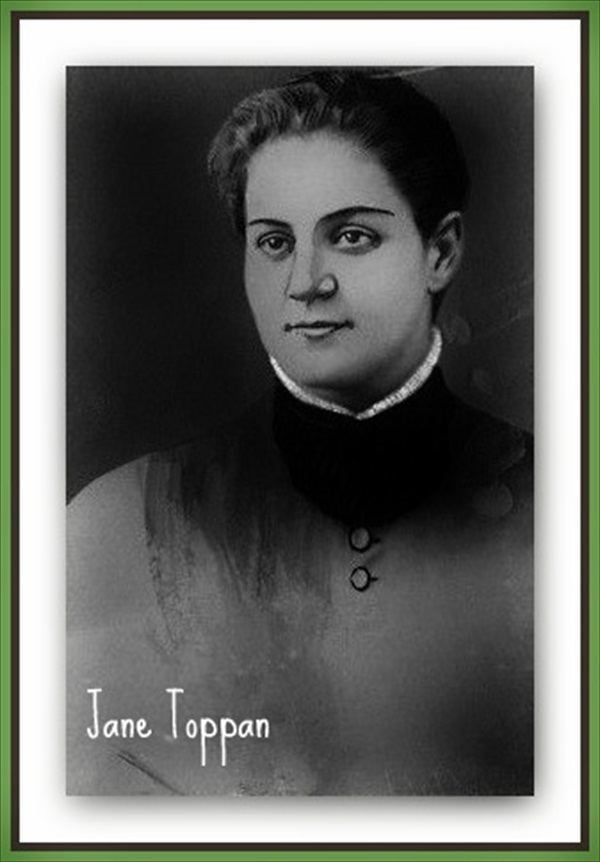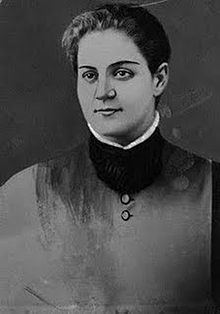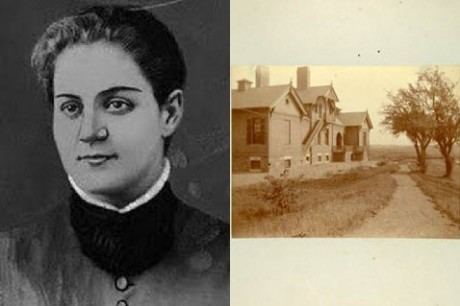Full Name Honora Kelley Name Jane Toppan Victims 31 | Span of killings 1895–1901 Country USA | |
Similar People Belle Gunness, Nannie Doss, Bertha Gifford, Amelia Dyer, Beverley Allitt | ||
Date apprehended October 29, 1901 | ||
Jane Toppan (1857–1938), born Honora Kelley, was an American serial killer, nicknamed "Jolly Jane". After her arrest in 1901, she confessed to 33 murders. She is quoted as saying that her ambition was "to have killed more people — helpless people — than any other man or woman who ever lived".
Contents
- THE TWISTED CASE OF JOLLY JANE TOPPAN
- Early life
- Murders
- Victims
- Fictional portrayals and legacy
- References

THE TWISTED CASE OF "JOLLY" JANE TOPPAN...
Early life

Though scant records survive of Toppan's early years, it is known that her parents were Irish immigrants, and her mother, Bridget Kelley, died of tuberculosis when she was very young. Her father, Peter Kelley, was well known as an alcoholic, very abusive, and eccentric, nicknamed by those who knew him "Kelley the Crack" (as in "crackpot"). In later years Kelley would become the source of many local rumors concerning his supposed "insanity", the most popular of which being that his madness finally drove him to sew his own eyelids closed while working as a tailor.

In 1863, only a few years after his wife's death, Kelley took his two youngest children, the eight-year-old Delia Josephine and six-year-old Honora, to the Boston Female Asylum, an orphanage for indigent female children founded in 1799 by Mrs. Hannah Stillman. Kelley surrendered the two young girls, never to see them again. Documents from the asylum note that the two girls were "rescued from a very miserable home".

No records of Delia and Honora's experiences during their time in the asylum exist, but in less than two years, in November 1864, Honora Kelley was placed as an indentured servant in the home of Mrs. Ann C. Toppan of Lowell, Massachusetts. (Indentured servitude was a labor system in which people paid for their passage to the New World by working for an employer for a fixed term of years. It was widely employed in the 18th century in the British colonies in North America and elsewhere. It was a way for the poor in Britain and the German states to obtain passage to the American colonies.) Though never formally adopted by the Toppans, Honora took on the surname of her benefactors and eventually became known as Jane. The Toppan original family already had a daughter, Elizabeth; she and Jane did not get along.
Murders

In 1885, Toppan began training to be a nurse at Cambridge Hospital. While she was there she had a lot of friends, and was well liked. Unlike her early years, where she was described as brilliant and terrible, at the hospital she was well liked, bright and friendly. Once Jane became close with the patients, she picked her favorite ones. The patients were normally elderly, and very sick. During her residency, she used her patients as guinea pigs in experiments with morphine and atropine; she would alter their prescribed dosages to see what it did to their nervous systems. However, she would spend considerable time alone with patients, making up fake charts and medicating them to drift in and out of consciousness and even getting into bed with them.
It is unknown if any sexual activity went on when her victims were in this state but when Toppan was questioned (after her arrest), she stated she derived a sexual thrill from patients being near death, coming back to life and then dying again.
Toppan would administer a drug mixture to the patients she chose as her victims, lie with them and hold them close to her as they died. Toppan is considered an ‘angel of death’, a type of serial killer who takes on a caretaker role and attacks the vulnerable and dependent.
She was recommended for the prestigious Massachusetts General Hospital in 1889; there, she claimed several more victims before being fired the following year. She briefly returned to Cambridge but was soon dismissed for administering opiates recklessly. She then began a career as a private nurse and flourished despite complaints of petty theft.
She began her poisoning spree in earnest in 1895 by killing her landlords. In 1899, she killed her foster sister Elizabeth with a dose of strychnine. In 1901, Toppan moved in with the elderly Alden Davis and his family in Cataumet to take care of him after the death of his wife (whom Toppan herself had murdered).
Within weeks, she killed Davis and two of his daughters. She then moved back to her hometown and began courting her late foster sister's husband, killing his sister and poisoning him so she could prove herself by nursing him back to health. She even poisoned herself to evoke his sympathy. The ruse did not work, however, and he cast her out of his house.
The surviving members of the Davis family ordered a toxicology exam on Alden Davis' youngest daughter. The report found that she had been poisoned, and local authorities put a police detail on Toppan. On October 29, 1901, she was arrested for murder. By 1902, she had confessed to 31 murders. On June 23, in the Barnstable County Courthouse, she was found not guilty by reason of insanity and committed for life in the Taunton Insane Hospital.
Soon after the trial, one of William Randolph Hearst's newspapers, the New York Journal, printed what was purported to be Toppan's confession to her lawyer that she had killed more than 31 people and that she wanted the jury to find her insane so she could eventually have a chance at being released. She remained at Taunton for the rest of her life. During her stay in Taunton, she told reporters that had she been married, and had a happy family, she never would have started the killings.
Victims
The victims are:
Fictional portrayals and legacy
In the independent film American Nightmare, written and directed by Jon Keves, Debbie Rochon portrays a serial killer named "Jane Toppan" who manages to kill numerous characters throughout the course of the film by various means. The character is also employed as a nurse. This character was inspired by Toppan.
Toppan was the subject of one of six monologues in the play Murderess by Anne Bertram, which premiered in St. Paul, Minnesota, at Theatre Unbound. She was portrayed by Laura Wiebers in the segment The Truth About Miss Toppan, directed by Mishia Burns Edwards. The play opened to favorable reviews. Minneapolis StarTribune theater critic William Randall Beard called the Toppan segment "a chilling portrait of a sociopath nurse."
Toppan was featured in an episode of Deadly Women and an episode of the podcasts Criminal and My Favorite Murder.
